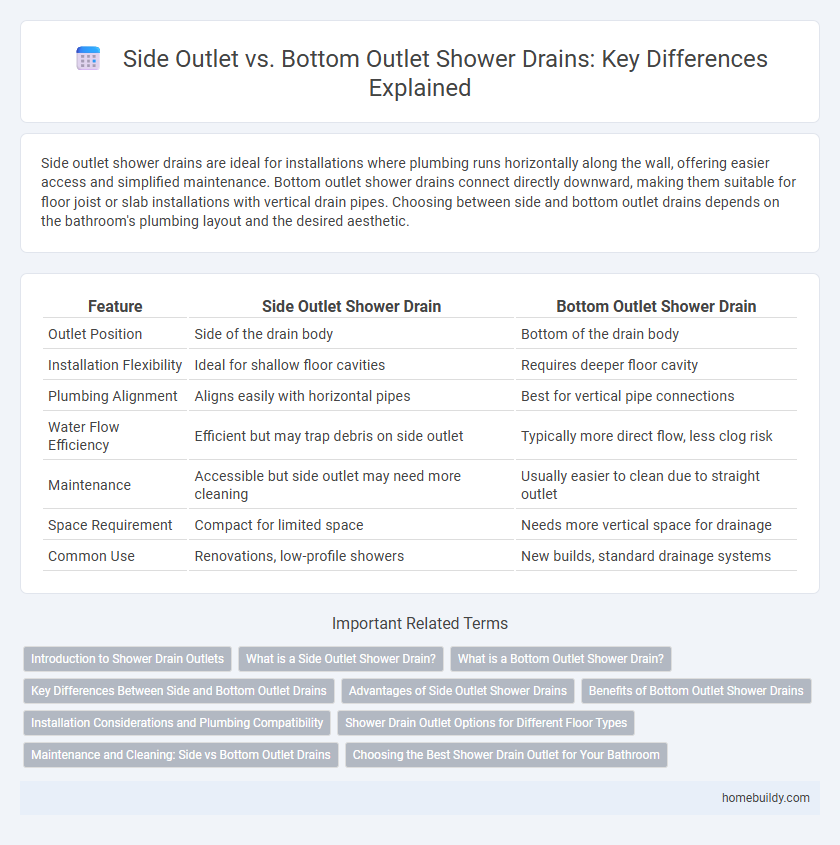Side outlet shower drains are ideal for installations where plumbing runs horizontally along the wall, offering easier access and simplified maintenance. Bottom outlet shower drains connect directly downward, making them suitable for floor joist or slab installations with vertical drain pipes. Choosing between side and bottom outlet drains depends on the bathroom's plumbing layout and the desired aesthetic.
Table of Comparison
| Feature | Side Outlet Shower Drain | Bottom Outlet Shower Drain |
|---|---|---|
| Outlet Position | Side of the drain body | Bottom of the drain body |
| Installation Flexibility | Ideal for shallow floor cavities | Requires deeper floor cavity |
| Plumbing Alignment | Aligns easily with horizontal pipes | Best for vertical pipe connections |
| Water Flow Efficiency | Efficient but may trap debris on side outlet | Typically more direct flow, less clog risk |
| Maintenance | Accessible but side outlet may need more cleaning | Usually easier to clean due to straight outlet |
| Space Requirement | Compact for limited space | Needs more vertical space for drainage |
| Common Use | Renovations, low-profile showers | New builds, standard drainage systems |
Introduction to Shower Drain Outlets
Shower drain outlets come in two primary types: side outlet and bottom outlet, each designed to suit specific plumbing layouts and bathroom configurations. Side outlet shower drains direct water horizontally, making them ideal for installations against walls or in tight spaces, while bottom outlet drains channel water vertically, best suited for floor-level plumbing connections. Choosing the appropriate outlet type enhances drainage efficiency and simplifies installation in various shower designs.
What is a Side Outlet Shower Drain?
A side outlet shower drain features a horizontal pipe connection that directs water flow through the drain's side rather than the bottom. Commonly used in installations where plumbing is situated within the wall or along the floor perimeter, this design facilitates easier alignment with existing pipework. Side outlet drains provide efficient drainage while minimizing the need for complex plumbing alterations compared to bottom outlet models.
What is a Bottom Outlet Shower Drain?
A bottom outlet shower drain features an outlet located directly underneath the drain body, allowing wastewater to flow vertically downward through the plumbing system. This design is ideal for showers with floor joists that allow vertical pipe runs, providing efficient drainage and reducing the risk of clogs. Compared to side outlet drains, bottom outlet drains require less horizontal plumbing space, making them suitable for compact bathroom layouts or renovations with limited side clearance.
Key Differences Between Side and Bottom Outlet Drains
Side outlet shower drains discharge water through an outlet located on the side of the drain body, making them ideal for installations with limited vertical space and facilitating easier pipe alignment. Bottom outlet shower drains direct water downward through an outlet at the base, offering a streamlined design suitable for shallow floor depths and often preferred for minimalist showers. Choosing between side and bottom outlet drains depends on floor construction, plumbing layout, and space constraints, impacting installation complexity and maintenance accessibility.
Advantages of Side Outlet Shower Drains
Side outlet shower drains offer easier installation in tight spaces where plumbing runs horizontally, reducing the need for complex pipe bends and minimizing clog risks. These drains enable efficient water flow away from the shower base, enhancing drainage speed compared to bottom outlet options. Their design allows for more flexible bathroom layouts, accommodating various plumbing configurations and simplifying maintenance access.
Benefits of Bottom Outlet Shower Drains
Bottom outlet shower drains offer enhanced water drainage efficiency by directing water flow directly downward, minimizing the risk of clogging and standing water. They provide greater flexibility in installation within various shower base designs, often requiring less space compared to side outlet drains. This orientation simplifies plumbing connections and maintenance, contributing to improved long-term durability and performance in bathroom drainage systems.
Installation Considerations and Plumbing Compatibility
Side outlet shower drains require specific wall plumbing configurations that accommodate horizontal pipe connections, making them ideal for installations where floor joists or subfloor space constraints limit vertical piping. Bottom outlet shower drains align with standard vertical drainage systems, simplifying installation in conventional bathroom layouts and ensuring greater compatibility with existing plumbing stacks. Choosing between side and bottom outlet options depends on the subfloor structure, available space, and the existing plumbing framework to optimize water flow and prevent leaks.
Shower Drain Outlet Options for Different Floor Types
Side outlet shower drains are ideal for tiled or concrete floors, allowing easier connection to horizontal drainage pipes and minimizing floor excavation. Bottom outlet shower drains work best with raised floor systems or timber floors, as the vertical outlet aligns directly with the plumbing below, reducing installation complexity. Choosing the appropriate outlet ensures efficient water drainage and maintains floor integrity across different flooring types.
Maintenance and Cleaning: Side vs Bottom Outlet Drains
Side outlet shower drains offer easier access for maintenance and cleaning since the outlet is located on the side, allowing simpler removal of clogs and debris without dismantling the entire drain assembly. Bottom outlet drains often require more effort to clean because the outlet is positioned beneath, potentially necessitating more extensive disassembly to reach blockages. Routine maintenance of side outlet drains can reduce the risk of water buildup and mold, enhancing overall shower hygiene.
Choosing the Best Shower Drain Outlet for Your Bathroom
Choosing the best shower drain outlet for your bathroom depends on space, plumbing configuration, and aesthetic preferences. Side outlet shower drains are ideal for corner installations and allow easier connection to horizontal pipes, reducing the need for additional fittings. Bottom outlet drains suit centralized drain locations, providing a direct vertical connection that can simplify pipe alignment and maintenance.
side outlet shower drain vs bottom outlet shower drain Infographic

 homebuildy.com
homebuildy.com